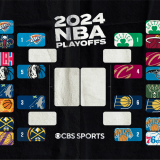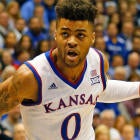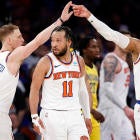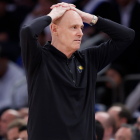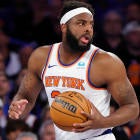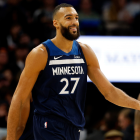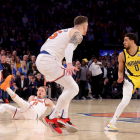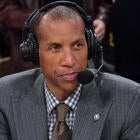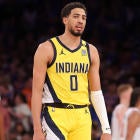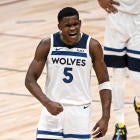When I think about NBA Drafts of the past, I'm not particularly fascinated by storylines surrounding LeBron James going No. 1, Kevin Durant going No. 2 or James Harden going No. 3.
The best draft stories are guys who slipped past dozens of teams and ended up landing in the perfect spot -- taken way lower than their future NBA success would indicate. Don't talk to me about Anthony Davis at No. 1. That's easy. My 4-year-old son could have made that pick.
Talk to me about the steals.
Like Draymond Green at No. 35. Or Jimmy Butler at No. 30. Or Hassan Whiteside at No. 33. Or Kawhi Leonard at No. 15, or Rudy Gobert at No. 27, or Isaiah Thomas at No. 60, or, heck, even Stephen Curry at No. 7 – that's a steal too.
We always talk about how NBA teams need superstars to go far in the playoffs and to win titles. That's true. But you don't always have to have the No. 1 pick to land a superstar. The best franchises in the NBA are built on the backs of steals like these guys, some of whom could become superstars, some of whom could far outperform their draft position.
Here are the biggest potential steals in the 2017 NBA Draft.
Luke Kennard, SG, Duke
Go ahead. Tell me about how Kennard is just another Kyle Korver. (Which, by the way, is still a pretty damn good thing.) Yes, Kennard may be the best 3-point shooter in this draft, but he may also be one of the best shot creators in this draft. There's been a decent amount of hype around Kennard the past few weeks. Silly questions about his supposed "lack of athleticism" have waned. He's going to end up where I expected him to end up all along -- late in the lottery -- and will become an always solid, sometimes spectacular piece for a winning NBA franchise.
Josh Hart, SG, Villanova
He is the Malcolm Brogdon of this draft -- a four-year college player from a winning program who showed progress in his development each year, and who will be ready to make an immediate contribution to an NBA team. Like Brogdon, Hart can shoot it. Like Brogdon, Hart can play lockdown defense on multiple positions. Like Brogdon, Hart can play a supporting role or step up to the challenge to be The Guy when needed. He can be a leader for a young team or can immediately hang with a veteran squad. An All-Star? No. But a late-first or early-second-round pick who can immediately make a big difference for any franchise in the league? Absolutely.
Harry Giles, PF, Duke
I've called him the biggest risk-reward pick since Joel Embiid. Like Embiid, we won't know for years whether Giles will be a star or a bust in the NBA (three years in and, with his shaky health, we still don't know with the incredibly talented Embiid). If you saw Giles play his one-and-done season at Duke, you probably wonder what the hell I'm talking about. He looked lost on the court -- a result of missing the entire preseason recovering from his second torn ACL -- and he looked tentative with his body, perhaps because he was afraid of tearing up a knee for the third time.
If you saw Giles play two years ago for Team USA's Under-19 squad, where he was often the best player on a team that included Jayson Tatum and Josh Jackson, you know exactly what I mean. Even with the injury risk, Giles could turn into a Kevin Garnett Light.
Frank Mason, PG, Kansas
Frank Mason's story could only happen in college basketball. Mason was committed to Towson in the Colonial Athletic Association when, the summer before his prep school season, a Kansas assistant saw him playing in a back gym, absolutely destroying future USC point guard Jordan McLaughlin. Kansas signed him, and each year he improved, culminating in winning national player of the year his senior year for a team that was good enough to have won it all.
Mason is a phenomenal shot creator who can really stroke it -- he hit more than 47 percent of his 3s last season and has reportedly wowed NBA teams in workouts with his shooting -- but his greatest assets are determination and tenacity. Yes, he's small. But there are few players in this draft who are tougher than Mason.
Cameron Oliver, PF, Nevada
If a team is looking for a high upside guy in the second round, Oliver is the pick. Oliver is a long, strong power forward who crashes the glass and can make shots. Was his 38.4 3-point shooting percentage last season a fluke? If not, Oliver is a steal for a team with patience. He's an explosive athlete who is absolutely cut. Certainly raw, but the right NBA team could develop Oliver into a versatile force at both ends of the court.
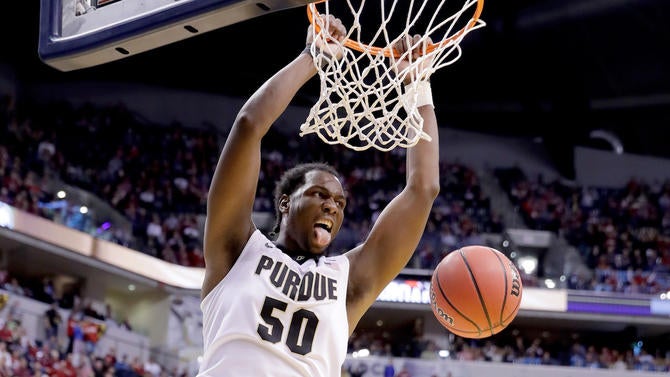
Caleb Swanigan, PF, Purdue
NBA teams will regret not taking Swanigan if he lasts into the second round. If he does last that long -- which I think would be silly -- it will be because of concerns over his athleticism. But Swanigan more than makes up for those concerns with a work ethic that was unparalleled in college hoops. Seriously: I've never seen a young man more focused on his goals than Biggie. He knows what his role will be in the NBA, as a down-and-dirty rebounder who can outmuscle you and who also happens to be a decent shooter. Coaches love high character guys. There aren't many dudes out there with a higher character than Swanigan, who overcame a rough childhood -- homelessness, obesity, family instability -- to be on the brink of the NBA. He's not a project. Biggie is ready to make a difference in the NBA.
Jonathan Isaac, SF, Florida State
He ought to be drafted in the five to seven range. Why could he be considered a steal so early? Because multiple scouts and coaches have told me they believe Isaac may have the highest ceiling in the entire draft. As much as pundits are singing the praises of players like Markelle Fultz, Lonzo Ball and Josh Jackson, make no mistake about it: Nobody in this draft is in the rarefied can't-miss air of players like LeBron James, Anthony Davis or Karl-Anthony Towns.
What makes this draft special isn't one transcendent superstar. It's that the top tier -- which probably lasts until right around the 10th pick -- is much larger than normal, and any player in that top tier could develop into an All-Star, perhaps a superstar. Isaac has height and length and out-of-this-world athleticism, a high basketball IQ and phenomenal versatility on offense and defense. Isaac is 6-11, and his college coach tells me he still may be growing. Just a couple years ago, though, he was only 6-6. Why does that matter? Because Isaac didn't grow up playing like a big man; he grew up working on his wing skills, just like a certain Anthony Davis, also a late bloomer. Isaac can shoot, pass and defend multiple positions. He's a near-7-footer who made 34.8 percent of his 3-pointers at Florida State. And he's humble, hard-working and coachable. A sure thing? Absolutely not. A steal if he hits? Certainly.
Jawun Evans, PG, Oklahoma State
Evans is one of the toughest college point guards I've seen. He may be the most underrated point guard in a draft overloaded with them. Evans might have been as valuable for his college team as any player in the country, someone who absolutely did it all. Like Mason, there are concerns about his size. Like Mason, Evans has the tenacity and determination to overcome that.
Luke Kornet, C, Vanderbilt
He may not even get drafted, but a team that lands him as an undrafted free agent could get a capable and versatile NBA big. Kornet holds the all-time NCAA record for 3-pointers made by a 7-footer, with 150. A 7-footer who can stroke it from deep? I think that's a valuable asset in today's NBA. Kornet is a competent rim protector as well. His name was floated as a possible first-rounder in past years, so it would surprise me if Kornet doesn't find a place with an NBA team.
Alec Peters, PF, Valparaiso
I put Peters in the first round of my final mock draft, though I believe he'll likely end up in the second round. Peters is not considered an "NBA athlete." What he is is one of the most reliable shooters in this entire draft. Ignore Peters' 36.3 percent shooting from three last season, when he was injured and when Horizon League teams loaded up on him. Instead look at his previous two seasons: 46.6 percent and 44 percent from 3-point range. He has deep NBA range. And he is a creative scorer inside the 3-point line as well. Peters won't be a star, but he can become a productive NBA player for a long time.







